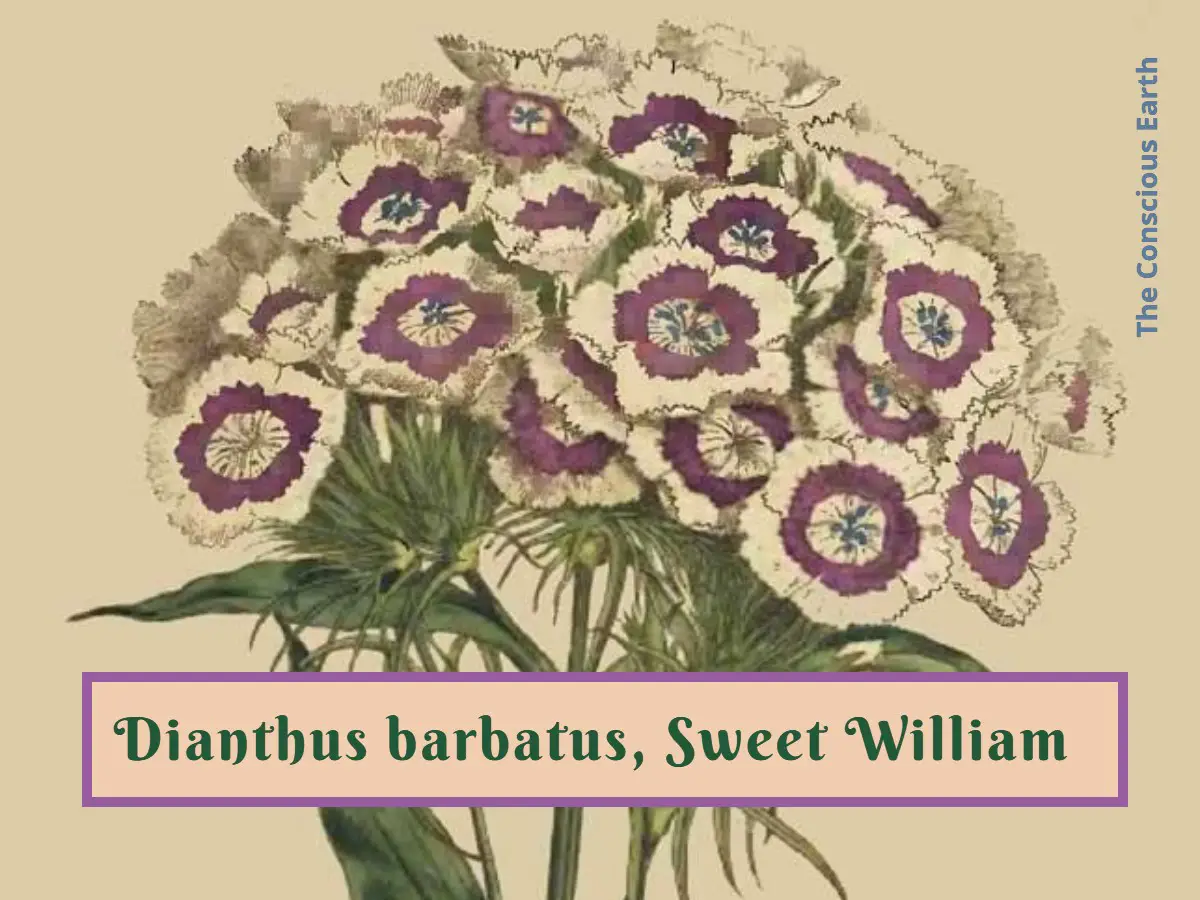
This is a wonderful plant to share with small children who delight in seeing flowers that are ‘their size”—at least that is how I saw them as a kid. The New York Botanical Garden highlighted the “kid-friendliness” of Sweet William in a lecture they hosted by Bill Calkins, a manager with the Ball Horticultural Company, he “mentioned that a child was twice as likely to appreciate gardening as an adult if they experienced nature first-hand with their parents.”1
According to Fine Gardening, Sweet William can be summed up like this: “These short-lived perennials or biennials are charming plants, and are worth their weight in gold in the cottage border. After flowering, the attractive foliage holds the space well.” 2
From William Curtis, writing in the U.K. in 1793, 3 “This plant likely originated in the Netherlands and was probably brought to this country. It has established itself as one of the longstanding residents of our gardens.
“While there are many exquisite varieties of this Dianthus species, florists haven’t dedicated the same level of focus and care to it as they have to its more popular relatives like the Pink and Carnation. Consequently, it might not have reached its full potential in terms of improvement. The illustration we present here aims to depict one of its most highly regarded types, specifically the Painted Lady variety. It features a deep, vibrant purple center, encircled by a pristine white outer section, with the petal edges showing slight indentations. However, it’s important to note that our depiction does not fully capture the original’s true beauty.
“Besides single flowers producing an infinite variety of colours, there are several double varieties of the Sweet William, some of which are observed to have more scent than others.
“To cultivate these plants to their utmost perfection, it is essential to renew them annually. Despite being perennial by nature, they tend to deteriorate over time, especially when grown in excessively wet or dry soil or in unpurified air. The single varieties should be propagated from seeds, carefully collected from the finest flowers, while the double types can be propagated through cuttings, pipings, or layers using methods similar to those employed for Pinks and Carnations. For optimal results, sow the seeds early in April, transplant the seedlings to a designated bed in June, spacing them about six inches apart in all directions, and, come September, they’ll be ready for relocation to the flower border. In their new location, they will bloom the following summer, gracing us with their flowers throughout June and July, and yield their seeds in August.” 3
This plant likely originated in the Netherlands and was likely introduced to this country, where it has become one of the long-standing inhabitants of our gardens.
While there are numerous beautiful varieties of this Dianthus species, it hasn’t received the same level of attention from florists as its more favored relatives, the Pink and Carnation. Consequently, it may not have reached its full potential. The “Painted Lady” variety, with its deep, rich purple center surrounded by pure white petals, is considered one of the most esteemed varieties. However, our depiction falls short of capturing the original’s true beauty.
In addition to single flowers that display a wide range of colors, there are several double varieties of Sweet William, some of which are noted for their pleasant fragrance.
To maintain these plants in their best condition, they should be renewed annually. While the root is perennial, it tends to deteriorate, especially in very moist or dry soils or if the air quality is poor. Single varieties should be grown from seeds, which should be saved from the finest flowers. Double varieties can be propagated through cuttings, pipings, or layers, similar to the methods used for Pinks and Carnations. Seedlings should be sown early in April, transplanted into a bed in June, with a spacing of about six inches in all directions. By September, they will be ready to be transplanted into the flower border, where they will bloom the following summer, typically in June and July, and mature their seeds in August.3
In the video below, Jeff Turner tells how to plant Sweet William, and even tells us how the plant got its name.
Sources:
1Uyterhoeven, Sonia. Kid-Friendly Annuals. New York Botanical Garden, Plant Talk. 28 May 2013.
2The Plant Guide. Sweet William, Dianthus barbatus. Fine Gardening.
3William Curtis. The Botanical Magazine or Flower-Garden Displayed, Vol. 6. London: Couchman & Fry, 1793. No. 207. [A Project Gutenberg ebook that carries this statement: This eBook is for the use of anyone anywhere at no cost and with almost no restrictions whatsoever. You may copy it, give it away or re-use it under the terms of the Project Gutenberg License included with this eBook or online at www.gutenberg.net]
Video: J. Parker’s. How to Plant Dianthus Barbatus (Sweet William). 28 September 2015.
—
R.A. Kroft writes about her day-to-day journey in living a smaller, more sustainable life and other topics that interest her.

This Site Was Inspired By An Interest in Protecting the Environment:
We had the privilege and joy of learning from Dr. Charlie Stine who instilled a love for the natural world through incredible field trips with the Johns Hopkins Odyssey Certificate program in Environmental Studies. At the time, the program was endorsed by the Maryland Department of Natural Resources. Sadly, after Dr. Stine retired, the program was phased out. We hope that we honor his legacy by shining a bright light on environmental issues and sharing good news about the success of various conservation programs when possible.
